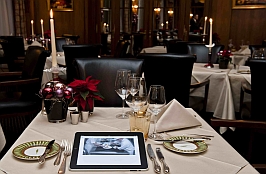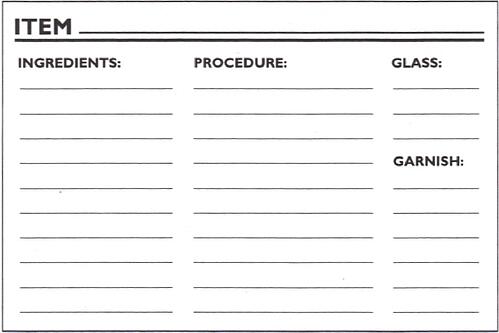The nightclub business can be a rough. With a plentitude of competing venues, and with customer tastes in constant flux, the average half-life of a bar or nightclub is all too brief. Survival can depend on your ability to stay ahead of the curve and be in tune with your customers’ ever-changing demands. In short, you need to be constantly aware of what’s in and what’s not in order to remain vital. Here is a brief compendium, in three parts, of some of the emerging and continuing trends in the industry, just a few things to look out for in 2012 and beyond:
Part 3 of 3: STORE CONCEPTS
 Simplicity over pretention. While bars that employ top-notch mixologists offering creative drinks will continue to attract more and more customers, you can also expect a trend towards simplicity. As David Wondrich put it in Nation’s Restaurant News, “The biggest trend I see is bringing mixology down to the fun/dive-bar level.” Expect to find well-made, “sophisticated” drinks in friendlier, “less sophisticated” surroundings.
Simplicity over pretention. While bars that employ top-notch mixologists offering creative drinks will continue to attract more and more customers, you can also expect a trend towards simplicity. As David Wondrich put it in Nation’s Restaurant News, “The biggest trend I see is bringing mixology down to the fun/dive-bar level.” Expect to find well-made, “sophisticated” drinks in friendlier, “less sophisticated” surroundings.
Live music and entertainment. Live acts are in. More and more bar patrons are looking to be entertained while they enjoy a drink or a bite. While live entertainment has always been a good way to drive traffic to your store, drinkers and diners—particularly the over thirty crowd—are starting to look for it more and more. Thanks to the Internet, booking these acts—whether a local band, a jazz singer or comedian--is easier than ever before. What’s more, social media sites like Facebook and Myspace allow you to gauge the kind of following these acts have, giving you some idea of the level of traffic you might expect.
Bottle Service. With economic recovery on the horizon, expect bottle service to once again gain popularity. While it never really went away—at least not in the VIP lounges of the latest hotspots—bottle-service popularity did wane a bit during the recent economic meltdown. Look for a comeback.
“Daylife”. Daylife has begun to rival nightlife in bars and clubs across the country, especially during summertime. Rooftop bars and hotel pool areas are natural “hotspots” on sunny days. But patrons’ willingness to partake in daytime drinking shouldn’t be ignored, even if your store lacks a rooftop, pool or courtyard area. A weekend brunch bash or an early happy hour on weekdays can be just as profitable. Expect more and more bars to begin taking advantage of customers’ gameness for early revelry.
Larger Nightclubs. Expect to see larger—20,000+ square-foot—venues opening up in major cities. Also expect some of these new mega clubs to be segmented into distinct areas within. Instead of roped off VIP areas, you’ll begin to see entirely separate enclaves, or mini-clubs, within the larger store.
Multi-use spaces. Hand in hand with the (re-)emergence of larger nightclubs is the trend toward multi-use venues. Instead of putting all their eggs in one basket, drinking establishments will increasingly employ versatile-design elements (such as colored glass walls that can be turned into projection TV’s) to start to cater to different clienteles. Expect to see multi-use spaces that can be turned into dance clubs, live-music venues and sports bars.

Cocktail trucks. Where not prohibited by law, expect to see cocktail trucks peddling alcoholic concoctions. You may have noticed food trucks on street corners of major U.S. cities. Often run by talented chefs and would-be restaurateurs (who may lack the requisite capital to establish a more permanent store), these trucks offer a various, often high-quality, fare. This trend is now being extended to potables. In San Francisco, BrewTrucs can be seen roving the streets hawking coctails and beer to thirsty pedestrians. Moreover, cocktail trucks have become a tool for liquor manufacturers nation-wide to build brand recognition. While legal issues will limit the growth of these bars on wheels, you may well see more and more of these trucks at parties and campus events.

 Making a good mixed drink isn't always a matter of A + B = C. In fact, there are numerous small details that can contribute to turning your creation into something just that little bit better than the norm and, more still, that can help you keep your ingredients at peak freshness and productivity. Consider the following:
Making a good mixed drink isn't always a matter of A + B = C. In fact, there are numerous small details that can contribute to turning your creation into something just that little bit better than the norm and, more still, that can help you keep your ingredients at peak freshness and productivity. Consider the following: The difference between a good and great martini is very small, but very important. The quality of your cocktail menu should be of paramount importance to you. The methods by which those cocktails are prepared should be a point of pride for all concerned.
The difference between a good and great martini is very small, but very important. The quality of your cocktail menu should be of paramount importance to you. The methods by which those cocktails are prepared should be a point of pride for all concerned. Going mobile. Google projects that mobile devices will overtake PCs as the most common Web-access device by 2013.The ubiquity of smartphones and tablets makes it imperative that Websites be mobile-friendly. As many of these devices either do not support or have trouble playing Flash content (which has become a staple of restaurant, nightclub and bar sites), you would be well-served to optimize your site to take advantage of the rapidly growing number of mobile users who rely on their iPhones and iPads to find where to go for a drink or a bite.
Going mobile. Google projects that mobile devices will overtake PCs as the most common Web-access device by 2013.The ubiquity of smartphones and tablets makes it imperative that Websites be mobile-friendly. As many of these devices either do not support or have trouble playing Flash content (which has become a staple of restaurant, nightclub and bar sites), you would be well-served to optimize your site to take advantage of the rapidly growing number of mobile users who rely on their iPhones and iPads to find where to go for a drink or a bite. Electronic cigarettes. Electronic cigarettes are becoming more and more ubiquitous. These electrical devices, which produce a flavored aerosol mist that simulates tobacco smoke, have become popular both as a way of quitting tobacco and as a way for smokers to kinda feed their habit in places where actual smoking is prohibited. Expect e-cigarettes to become a more common sight in bars and nightclubs in 2012. Also expect them to be sold more widely in drinking establishments. Not only do these devices provide an added revenue stream, they may actually have the added benefit of keeping smokers inside and drinking.
Electronic cigarettes. Electronic cigarettes are becoming more and more ubiquitous. These electrical devices, which produce a flavored aerosol mist that simulates tobacco smoke, have become popular both as a way of quitting tobacco and as a way for smokers to kinda feed their habit in places where actual smoking is prohibited. Expect e-cigarettes to become a more common sight in bars and nightclubs in 2012. Also expect them to be sold more widely in drinking establishments. Not only do these devices provide an added revenue stream, they may actually have the added benefit of keeping smokers inside and drinking.
 Herb-infused spirits. Whether they be whiskies, vodkas or gins are gaining herb-infused drinks are gaining in popularity. Expect gin, especially, to continue to make a splash as both large producers such as Bombay and a slew of new micro distilleries continue infuse this old stalwart with fresh and interesting botanicals.
Herb-infused spirits. Whether they be whiskies, vodkas or gins are gaining herb-infused drinks are gaining in popularity. Expect gin, especially, to continue to make a splash as both large producers such as Bombay and a slew of new micro distilleries continue infuse this old stalwart with fresh and interesting botanicals. Seasonal and flavored beers. While nothing new, seasonal and/or flavored beers are starting to gain traction.
Seasonal and flavored beers. While nothing new, seasonal and/or flavored beers are starting to gain traction. Value. After several years of economic recession, consumers have acquired a taste for value wines. They are seeking bang for the buck—not cheap inferior wines, but good, well-balanced, flavorful wines at an affordable price. With many of these wines coming from Spain and South America, expect Spanish, Chilean and Argentinian wines to continue to grow in popularity.
Value. After several years of economic recession, consumers have acquired a taste for value wines. They are seeking bang for the buck—not cheap inferior wines, but good, well-balanced, flavorful wines at an affordable price. With many of these wines coming from Spain and South America, expect Spanish, Chilean and Argentinian wines to continue to grow in popularity.
 When you design your service area, it's important to realize that every step a bartender takes in the serving of a drink is costing you money and making your customers impatient. Where does your staff need to walk to get a clean glass? How far from there to the ice bins and then to the spirit dispenser? And where are your soda guns in relation to the bottles? Is the cash register yet another trip away from the customer? Even if your bartender has to take only four or five steps between each of these posts, consider how far that means your bartender has to walk in the course of serving 500 drinks a night! This is bad enough for a solo bartender, but when two or three people are working behind the same bar and sharing facilities, it can be an unproductive nightmare.
When you design your service area, it's important to realize that every step a bartender takes in the serving of a drink is costing you money and making your customers impatient. Where does your staff need to walk to get a clean glass? How far from there to the ice bins and then to the spirit dispenser? And where are your soda guns in relation to the bottles? Is the cash register yet another trip away from the customer? Even if your bartender has to take only four or five steps between each of these posts, consider how far that means your bartender has to walk in the course of serving 500 drinks a night! This is bad enough for a solo bartender, but when two or three people are working behind the same bar and sharing facilities, it can be an unproductive nightmare. Have you ever sat under a blue neon light for an hour? While neon decor might look great when a bar is packed to capacity and the music is pumping, when business is slow it's like a power drill closing in on the center of your forehead. Certainly your customers should be impressed by your decor, but will the very look that draws them in end up driving them away early? Consider the following:
Have you ever sat under a blue neon light for an hour? While neon decor might look great when a bar is packed to capacity and the music is pumping, when business is slow it's like a power drill closing in on the center of your forehead. Certainly your customers should be impressed by your decor, but will the very look that draws them in end up driving them away early? Consider the following: The way your bar operates depends on many factors, one of the most important being the "machinery" of the bar. Sometimes, no matter how efficient your staff, the bar just isn't set up to allow maximum productivity. Avoid that happening to your bar.
The way your bar operates depends on many factors, one of the most important being the "machinery" of the bar. Sometimes, no matter how efficient your staff, the bar just isn't set up to allow maximum productivity. Avoid that happening to your bar. Accounting (bookkeeping) theft is a major concern within the beverage industry. From falsifying daily inventory records to complicated auditing abuse, this area of theft is often the most difficult to detect. Sometimes, it is the managers themselves who are behind the scams. Owners need to be aware of the following possibilities:
Accounting (bookkeeping) theft is a major concern within the beverage industry. From falsifying daily inventory records to complicated auditing abuse, this area of theft is often the most difficult to detect. Sometimes, it is the managers themselves who are behind the scams. Owners need to be aware of the following possibilities: Theft reduction policies and procedures are no good unless they are strictly enforced. Employees must be made clearly aware of the dire consequences of flouting house rules. There can be no gray areas. New members of staff should be asked to sign a confirmation that they have read the rules and fully understand the implications.
Theft reduction policies and procedures are no good unless they are strictly enforced. Employees must be made clearly aware of the dire consequences of flouting house rules. There can be no gray areas. New members of staff should be asked to sign a confirmation that they have read the rules and fully understand the implications.
